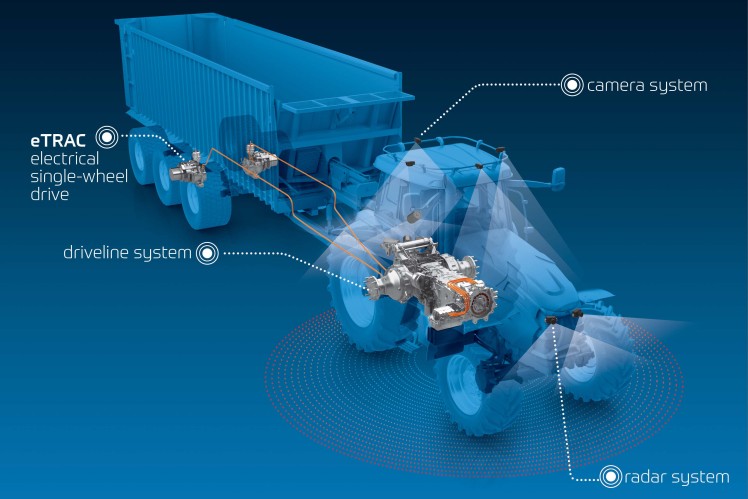ZF is Smart Farming Intelligent mechanical systems by ZF – Smart Farming for Tomorrow´s agriculture
- Safety – Radar technology for environment detection
- Connectivity – Intelligent vehicle and implement interconnection
- Intelligent Drive Strategy – Predictive drive strategies for agricultural machinery

Ideally, the farming of the future should not only be climate neutral, but it should also operate safely and efficiently.
In order to ensure this, ZF is already developing future-oriented technologies today and demonstrates once more its aspiration as a technology leader with system capability.
Safety
Radar technology for environment detection
Observation Assist
Gen5 Short-Range Corner Radar sensors support functions such as the „Observation Assist” (fig 17). Environment can be detected within a range of up to 90 meters in a grid of 20 centimeters and an opening angle of +/- 75 degrees.
- Short-Range Radar sensor for an extended environment detection
- New high-performance forward-looking radar system for early object detection
Blind Spot Assist
When tractors turn, dangerous situations for pedestrians and cyclists often can arise. Short range corner radars monitor the traffic to the sides and recognize bike riders or pedestrians even at night and in the blind spot area. The critical zone is the area to the left and right of the cab with poor driver visibility and the area of the curve radius made by the trailer. If people or objects are detected, the driver will be warned. The ZF Blind Spot Assist can thus help to prevent serious accidents.
Connectivity – Intelligent vehicle and implement interconnection
ZF shows how vehicles and implements can be intelligently connected and how vehicle manufacturers as well as farmers can be supported by new communication technologies and platforms. Thanks to its broad portfolio, ZF is able to interpret trends across all sectors and thus creates synergies in an agile way.
- Reduction of vehicle downtime through predictive maintenance und condition monitoring
- Rapid data transmission for specialists
- DIY support, e.g. through online access to operating manuals
- Avoidance of secondary damage
- Enhanced maintenance intervals
ZF offers two variants of connectivity solutions.
Connectivity Basic – Bluetooth Low Energy (BLE)
The new ZFlink (BLE Dongle) connects the tractor with smartphone or tablet using the OBD2 diagnosis interface. With ZFLink and the associated mobile device application (ZF AgriApp), vehicle data, operating conditions and service data can be read and analyzed at any time (fig 18 and 19). In case of active errorcodes ZF can offer assistance in solving the problem by oneself (DIY). If a DIY solution can not be found, data can also be transferred to the next ZF service point. To this ZF uses a specially developed ZF app. It is intended to provide the end user with a simple diagnosis assistance in addition to numerous analysis tools.
Connectivity Premium
The open ZF IoT platform makes it possible to implement new, digital services and to use hardware systems more efficiently through data analysis and smart algorithms. Let's take the example of data analysis for off-highway vehicles: agricultural machinery drivelines are monitored across their entire product life cycle via cloud (fig 20). That contributes to reducing downtime, as potential problems or even damage can be recognised and fixed at any early stage.
ZF Equipment and Asset Tracking
DeTAGtive makes smooth tracking possible for agricultural companies that wish to monitor equipment or machinery. They can use such data for predictive maintenance with minimum downtime. The BLE tags (Bluetooth Low Energy) provide information on operating hours, resource intensity and surrounding conditions while being installed in trailers, machines or goods. The tags have been optimized for the harsh operating conditions in work machinery and on the field. (fig 21)
- Up to 70 meters range
- Global Bluetooth technology as a standard technology
- No need for costly reading devices
- Highly flexible and scalable design
Intelligent Drive Strategy (IDS) – Predictive drive strategies for agricultural machinery
Predictive driving strategies are already used in varieties for vehicles on the streets. There are systems for frucks for example, that influence the transmission shift program and also the vehicle speed based on GPS data and precise map information. Similar systems are also available for cars. These systems react to approaching vehicles through environment detection sensors as well as uphill gradients and turns form precise map data.
The goal of this functions is to increase the driving comfort and decrease the fuel consumption. The implementation of these funcionalities are way more complex off road. On one hand precise map data is not available yet, on the other hand the environmental conditions like dirt and dust are problems which are more complex to overcome. This is why special solutions are required.
ZF presents a predictive driving strategy using radar sensors which get along without precise map data and connectivity, also radar pollution is not a problem. Furthermore the integration of this system into the vehicle takes lower effort compared to well-known systems on the road. ZF has successfully implemented the integration of a radar sensor with associated detection as well as reaction function into Off-Highway machinery. The environment detection sensor continuously provides information about the off-road pattern ahead of the vehicle. These are processed for the driving strategy in order to build up or reduce power resources.
With the predictive driving strategy it is now possible to achieve significant performance increase or reduction of fuel consumption through a driving strategy which is adapted to the future topography. This in addition means less stress for the driver. In case of manual transmissions a clear optimization of the shift times and the gear selection as well as the reduction of the shift frequency can be achieved.
Due to this Intelligent Drive Strategy it is possible for the first time to respond anticipatory to a changing topography without the existence of highly accurate map data.
One possible use case is the slope detection with the corresponding optimization of the driving strategy.
Intelligent mechanical systems by ZF – Smart Farming for Tomorrow´s agriculture
- Safety – Radar technology for environment detection
- Connectivity – Intelligent vehicle and implement interconnection
- Intelligent Drive Strategy – Predictive drive strategies for agricultural machinery

Ideally, the farming of the future should not only be climate neutral, but it should also operate safely and efficiently.
In order to ensure this, ZF is already developing future-oriented technologies today and demonstrates once more its aspiration as a technology leader with system capability.
Safety
Radar technology for environment detection
Observation Assist
Gen5 Short-Range Corner Radar sensors support functions such as the „Observation Assist” (fig 17). Environment can be detected within a range of up to 90 meters in a grid of 20 centimeters and an opening angle of +/- 75 degrees.
- Short-Range Radar sensor for an extended environment detection
- New high-performance forward-looking radar system for early object detection
Blind Spot Assist
When tractors turn, dangerous situations for pedestrians and cyclists often can arise. Short range corner radars monitor the traffic to the sides and recognize bike riders or pedestrians even at night and in the blind spot area. The critical zone is the area to the left and right of the cab with poor driver visibility and the area of the curve radius made by the trailer. If people or objects are detected, the driver will be warned. The ZF Blind Spot Assist can thus help to prevent serious accidents.
Connectivity – Intelligent vehicle and implement interconnection
ZF shows how vehicles and implements can be intelligently connected and how vehicle manufacturers as well as farmers can be supported by new communication technologies and platforms. Thanks to its broad portfolio, ZF is able to interpret trends across all sectors and thus creates synergies in an agile way.
- Reduction of vehicle downtime through predictive maintenance und condition monitoring
- Rapid data transmission for specialists
- DIY support, e.g. through online access to operating manuals
- Avoidance of secondary damage
- Enhanced maintenance intervals
ZF offers two variants of connectivity solutions.
Connectivity Basic – Bluetooth Low Energy (BLE)
The new ZFlink (BLE Dongle) connects the tractor with smartphone or tablet using the OBD2 diagnosis interface. With ZFLink and the associated mobile device application (ZF AgriApp), vehicle data, operating conditions and service data can be read and analyzed at any time (fig 18 and 19). In case of active errorcodes ZF can offer assistance in solving the problem by oneself (DIY). If a DIY solution can not be found, data can also be transferred to the next ZF service point. To this ZF uses a specially developed ZF app. It is intended to provide the end user with a simple diagnosis assistance in addition to numerous analysis tools.
Connectivity Premium
The open ZF IoT platform makes it possible to implement new, digital services and to use hardware systems more efficiently through data analysis and smart algorithms. Let's take the example of data analysis for off-highway vehicles: agricultural machinery drivelines are monitored across their entire product life cycle via cloud (fig 20). That contributes to reducing downtime, as potential problems or even damage can be recognised and fixed at any early stage.
ZF Equipment and Asset Tracking
DeTAGtive makes smooth tracking possible for agricultural companies that wish to monitor equipment or machinery. They can use such data for predictive maintenance with minimum downtime. The BLE tags (Bluetooth Low Energy) provide information on operating hours, resource intensity and surrounding conditions while being installed in trailers, machines or goods. The tags have been optimized for the harsh operating conditions in work machinery and on the field. (fig 21)
- Up to 70 meters range
- Global Bluetooth technology as a standard technology
- No need for costly reading devices
- Highly flexible and scalable design
Intelligent Drive Strategy (IDS) – Predictive drive strategies for agricultural machinery
Predictive driving strategies are already used in varieties for vehicles on the streets. There are systems for frucks for example, that influence the transmission shift program and also the vehicle speed based on GPS data and precise map information. Similar systems are also available for cars. These systems react to approaching vehicles through environment detection sensors as well as uphill gradients and turns form precise map data.
The goal of this functions is to increase the driving comfort and decrease the fuel consumption. The implementation of these funcionalities are way more complex off road. On one hand precise map data is not available yet, on the other hand the environmental conditions like dirt and dust are problems which are more complex to overcome. This is why special solutions are required.
ZF presents a predictive driving strategy using radar sensors which get along without precise map data and connectivity, also radar pollution is not a problem. Furthermore the integration of this system into the vehicle takes lower effort compared to well-known systems on the road. ZF has successfully implemented the integration of a radar sensor with associated detection as well as reaction function into Off-Highway machinery. The environment detection sensor continuously provides information about the off-road pattern ahead of the vehicle. These are processed for the driving strategy in order to build up or reduce power resources.
With the predictive driving strategy it is now possible to achieve significant performance increase or reduction of fuel consumption through a driving strategy which is adapted to the future topography. This in addition means less stress for the driver. In case of manual transmissions a clear optimization of the shift times and the gear selection as well as the reduction of the shift frequency can be achieved.
Due to this Intelligent Drive Strategy it is possible for the first time to respond anticipatory to a changing topography without the existence of highly accurate map data.
One possible use case is the slope detection with the corresponding optimization of the driving strategy.
MEDIA
CONTACT

